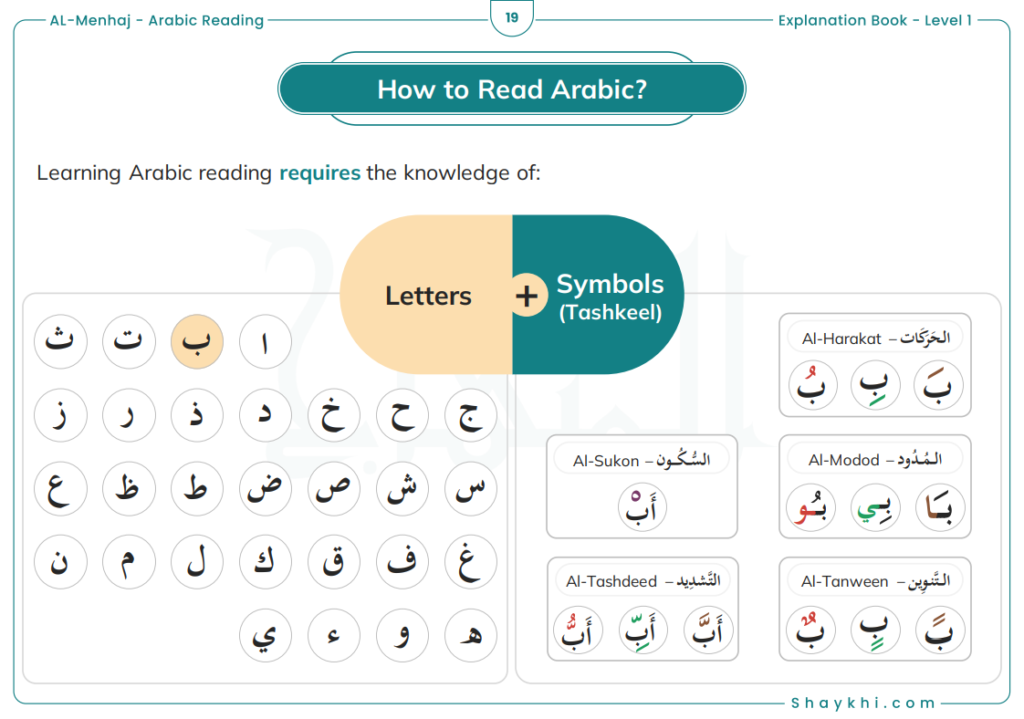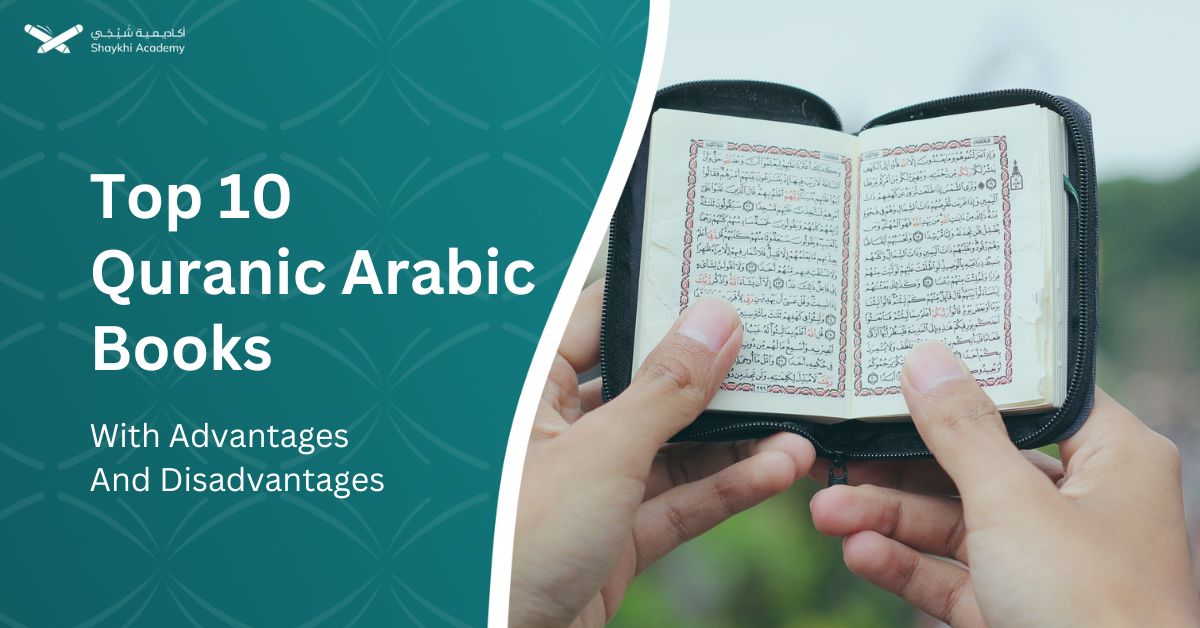Quranic Arabic Books: In the pursuit of a deeper understanding of the Quran, mastering the intricacies of its original language, Arabic, becomes an indispensable journey for scholars and enthusiasts alike. Countless books have been crafted to facilitate this noble endeavor, offering insights into the linguistic nuances, grammatical structures, and contextual meanings embedded in the sacred text.
In this comprehensive guide, we will delve into ten Quranic Arabic books, each bearing its unique significance, providing readers with a roadmap to nPDFavigate the vast realm of Quranic language study.
Quranic Arabic Book: “Al-Menhaj” By Shaykh Luqman El-Kasabany:
El-Kasabany’s “Al-Menhaj” serves as a foundational guide of a systematic approach directed to non-Aabic speakers from adult beginners in reading Quranic Arabic. This book is specifically crafted to aid learners in developing the fundamental skill of reading the Quran with correct pronunciation and Tajweed rules. The content is structured to gradually introduce learners to Arabic letters and vowels, with some examples of Quranic verses.

The Outline Of “Al-Menhaj” Quranic Arabic Book
“Al-Menhaj” book is outlined in three main parts, supported by many chapters for each:
- The first part serves as a motivation for Arabic learners by providing some important reasons behind learning Arabic from an Islamic point of view. By understanding “why”, you can easily move on to “how”.
- The second part delves into the Arabic alphabet letters providing some practical methodologies for their correct pronunciation. For example, it introduces the points of articulation and major qualities of letters visually and simply so that it is suitable for beginners. Also, it sets some similarities and differences between Arabic and English sounds to help the learner correlate to his familiar sounds and make it easier.
- The third part represents the Arabic symbols (Tashkeel) as a pillar for the mechanism of the Quranic reading. The Arabic symbols include harakat (voweled sounds), mudud (lengthened sounds), sukoon (non-voweled sounds), tashdeed (stressed sounds), and tanween (nazal sounds).
Overall, the book provides an answer to the why and how questions related to reading the Quran practically and simply.

The Significance Of “Al-Menhaj” Quranic Arabic Book
With clear explanations, exercises, visual elements and diagrams, “Al-Menhaj” book is designed to provide a solid start for those stepping into the realm of Quranic reading. Visual elements can enhance the learning experience by providing clear demonstrations of mouth and tongue positions for correct pronunciation.
You can start your Quranic reading journey for a better learning experience with Shaykhi Academy, the producer of this book!
Download the PDF from here for free.
Second Quranic Arabic Book: “At-Tajweed Al-Musawwar”
“At-Tajweed Al-Musawwar” is a book authored by Ayman Rushdi Swayd, focusing on the art and rules of Tajweed in the recitation of the Quran. The book is designed to provide intermediate learners with a comprehensive guide to mastering the correct pronunciation, intonation, and articulation required for beautiful and accurate Quranic recitation. The key features of the book are:
Tajweed Rules: The book likely covers the fundamental rules of Tajweed, including characteristics of letters, the proper pronunciation of Arabic sounds, and rules related to elongation (Madd) and pausing (Waqf).
Visual Aids: The inclusion of visual aids, illustrations, or diagrams as suggested by the term “Al-Musawwar” (The Illustrated).
Read also: Best Books To Learn Arabic For Beginners and Kids.
Third: Easy Qur’an Reading With Baghdadi Primer
The “Easy Qur’an Reading with Baghdadi Primer” by Moustafa Elgindy is an instructional book derived from the original Baghdadi Qaida. Tailored for children and beginner adults, the book employs a gradual teaching system for learning Arabic alphabet and reading skills. Unlike traditional methods, it introduces the alphabet first, progressing to forming words, and then constructing Arabic sentences, following a curriculum utilized in Egyptian hifz schools.
What sets this version apart is an increased focus on articles and a multitude of exercises for each lesson. Noteworthy features include explanations of the closed and open forms of the taa letter, insights into Hamzat al-wasl usage at the start of the Qur’an, and rules for when two letters with sukoon meet with basics of tajweed and general practice.
Read an indepth discussion on How Long Does It Take To Learn Arabic?
Fourth: Noorani Qa’idah Book
The “Noorani Qaidah” program authored by Noor Mohammad, stands as a renowned and highly effective method for Muslims seeking mastery in the art of Qur’anic recitation and Noorani Tajweed rules. Designed for individuals, regardless of whether Arabic is their native language, the Noorani Qaidah offers a comprehensive and efficient approach to learning how to read the Qur’an quickly.
What sets this program apart is its remarkable effectiveness in teaching Tajweed rules with ease, making it accessible to Muslims at various levels of proficiency. One of its notable features is its inclusivity – learners do not need prior knowledge of Arabic to embark on this transformative journey. By the program’s conclusion, participants achieve the ability to read and recite the Qur’an cover to cover. Thus, regardless of their linguistic background, Quranic Arabic learners can master the noble art of Qur’anic recitation in a relatively short period.
Fifth Quranic Arabic Book: “Al-Arabiyah Bayna Yadayk”
The “Al-Arabiyah Bayna Yadayk” series, authored by Dr. Abdul Rahman Ibn Ibrahim and others, is designed as a comprehensive Arabic language learning resource. The series typically follows a structured approach, catering to learners of various levels, from beginners to advanced, with a particular focus on Quranic Arabic. This comprehensive course takes a communicative approach, seamlessly integrating language skills with a deep understanding of Quranic verses.
The series is provided in 4 levels, each one consists of 2 student book with a teacher guide. Moreover, each level of the series includes textbooks, workbooks, and audiovisual materials, making it a holistic and engaging resource for students at various proficiency levels. The series places a special emphasis on practical application, ensuring that learners not only grasp the intricacies of Quranic Arabic but also develop the ability to use the language in real-life contexts.
Sixth: “Learning Arabic Language Of The Quran”
Izzath Uroosa’s Learning Arabic Language of the Quran is a book designed to help learners acquire proficiency in the Arabic language, specifically to understand the Quran. The book focuses on linguistic aspects that are relevant to comprehending the Quranic text. Thus, its main scope is Arabic grammar enhanced with examples exclusively chosen from the Quranic words.
Seventh: “Dictionary Of The Holy Quran: Arabic – English”
The “Dictionary of the Holy Quran: Arabic – English” by Abdul Mannan Omar serves as a valuable resource for individuals seeking a comprehensive understanding of the Quranic text revealed in Arabic. This dictionary is designed to facilitate the exploration of Arabic terms used in the Quran by providing clear and accurate English translations. The author, Abdul Mannan Omar, aims to bridge linguistic gaps for readers who may not be fluent in Arabic, enabling them to comprehend the meanings of Quranic words and phrases.
Whether for students, scholars, or general readers, this Arabic-English dictionary is a valuable companion for those seeking linguistic clarity and deeper insights into the profound messages embedded in the Noble Arabic Quran.
Eighth Quranic Arabic Book: Lane’s “Arabic-English Lexicon”
- Edward William Lane’s Lexicon is a monumental work that provides readers with valuable insights into the linguistic roots and meanings that underpin Quranic verses. It is an indispensable reference for upper-intermediate and advanced students of Quranic Arabic. Still, the lexicon is not exclusively focused on the Quran; it spans the Arabic language’s historical and cultural dimensions as well.
- “Understanding the Quran: Themes and Style” by Muhammad Abdel Haleem:
- Haleem’s book explores the thematic structures and linguistic styles employed in the Quran. With a focus on coherence and eloquence, this work enables readers to appreciate the unique literary qualities of the Quran. It serves as an excellent companion for those seeking to understand the Quran not only for its content but also for its unparalleled linguistic beauty.
Nineth: “Access To Qur’anic Arabic”
- Series of “Access to Qur’anic Arabic” authored by Abdul Wahid Hamid includes a textbook, workbook and selections targeting Quranic Arabic learners.
- 1. The Textbook introduces Arabic grammar and structure using Qur’anic words, employing three Word Lists based on word frequency in the Qur’an. With a user-friendly design and selective vocabulary, it facilitates an efficient learning experience.
- 2. The Workbook, complementing the Textbook, offers stimulating exercises using vocabulary and sentences exclusively from the Qur’an. It reinforces theoretical knowledge, introduces un-vowelled Arabic text, and enhances reading accuracy.
- 3. The Selections book features 110 annotated passages from the Qur’an, illustrating Textbook concepts. With parallel translations, notes, and a consolidated Vocabulary List, it provides diverse Qur’anic exposure in an accessible format.
Thus, this set empowers learners to navigate Quranic Arabic, fostering a profound connection with the sacred text.
Tenth: At-Tafseer Al-Muyassar
At-Tafseer Al-Muyassar is an Arabic Quranic exegesis simple book produced by King Fahd Complex for the Printing of the Holy Qur’an. It is suitable for Quranic Arabic learners to understand the Quran verses simply. Also, this book is suitable for non-Arabic learners with intermediate levels in Arabic to understand.
Advantages Of Studying These Books:
In essence, these ten Quranic Arabic books serve as beacons guiding learners of varying proficiency levels, ensuring a gradual and structured progression in understanding the language of the Quran. From Arabic grammar to vocabulary, to basics of Quran recitation practical rules and tajweed, each book contributes a unique dimension to the multifaceted landscape of Quranic language studies.
This diverse collection empowers students to embark on a journey of linguistic proficiency, spiritual enrichment, and a deeper connection with the divine message encapsulated in the Quran.
Start Your Quranic Arabic Journey With Native Arabic Tutors At Shaykhi Academy
To make your journey more fruitful and consistent, start it with Shaykhi Academy. They offer many programs aiming at supporting you in mastering your recitation and becoming close to the Arabic language of the Quran.
Start your Quranic Arabic course where you can learn, understand, and read Arabic.
Also, there are a variety of options for kids:
- Online Arabic classes for kids where they learn Arabic from early ages to be connected to Islam.
- Arabic Noorani Qaida Course where your kids become able to read and write the Quran words.
- Tajweed Rules for Kids course where your kids learn how to recite the Quran with confidence.

Our Quranic Arabic Books
One of the best books for teaching Tajweed and Arabic reading straightforwardly and understandably that enables you to advance at whatever level you’re at, from a novice to an expert, is the Shaykhi Academy series of books :
• Al-Menhaj – Arabic Reading Book – Part 1 (Beginners).
• Al-Menhaj – Arabic Reading Book – Part 2 (Intermediate learners).
• Al-Menhaj – Arabic Reading Book – Part 3 (Advanced learners).
The method of our books is based on gradual education in order that the students do not feel difficult or suffering, we also choose highly qualified teachers so that they can teach you correctly, our teachers are mainly concerned with improving your pronunciation of words and make sure that your Place of articulation is correct.
Also, in addition to teaching you Tajweed, our teachers explain some of the rules of the Arabic language that you may encounter while learning the Holy Quran.They also use some Quranic Arabic books in order to clarify all the points that you may have difficulty understanding.

















































